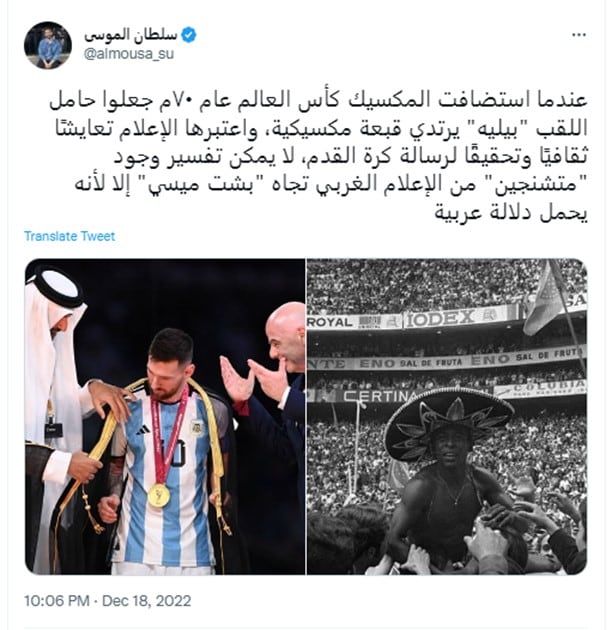During the awards ceremony for the FIFA World Cup, after Argentina emerged victorious from the final match it played against France on December 18, 2022, Qatari Emir Sheikh Tamim bin Hamad Al Thani dressed Lionel Messi, the captain of the Argentinian team, in a traditional Arab bisht – a robe worn widely on formal occasions by men in the Gulf. The fact that Messi was dressed in the bisht sparked extensive commentary and numerous reactions Arab social media, particularly in Qatar. Many people lavished praise on the emir describing the bisht as a symbol of Arabness and masculinity. Some contended that this move was a response to the West which they claimed disseminated deviant ideas and criticized Qatar's conservative character.

Qatari Emir dresses Messi in a bisht (Source:Twitter.com/AJArabic, December 18, 2022)
This report reviews several of the Tweets referred to above:
Praise For The Emir Of Qatar For Dressing Messi In A Bisht – A Symbol Of Arab Culture
Hamad Al-Kawari, Deputy Prime Minister of Qatar and president of the Qatar National Library tweeted: "The Western cinema and media have transformed the Arab garb – the ghutrah [a type of kaffiyeh worn in the Gulf], the agal [a special cord used to keep a kaffiyeh in place] and the bisht [a robe worn on formal occasions] – into a stereotype and a symbol of backwardness and terror. [However,] Qatar at the World Cup 2022, has transformed them into a symbol of a culture of ideas, literature, science, values and success – the culture of the Arabs. #ThanksToQatar and #ThanksToEmirTamimBinHamad."[1]
Al Jazeera presenter Mohamed Krichen tweeted: "The dressing of the player Lionel Messi in the traditional, respected Qatari bisht by the emir Tamim was a clever Qatari finishing touch at the World Cup, which was excellent in every way. Bravo to Qatar, which was creative and convinced and amazed the entire world."[2]
An English-language message tweeted by Al Jazeera journalist Nisreen Baddur reads, "Not only the best World Cup in history. This bisht was the icing to [sic] the cake. So proud of Qatar."[3]
Director-General Of The Qatar News Agency: A Symbolic Act Which Emphasizes Our Identity Which Is Far From Deviant Ideas
Ahmed Saeed Jabor Al Rumaihi, Director-General of the Qatar News Agency, tweeted: "The hatred-ridden Western media condemns Messi's wearing of the bisht and defile it. It does not understand the depth of this wise act and the symbolism they wanted to convey to the world by emphasizing our identity and our heritage which is far from their deviant ideas."[4]

In a similar vein, Qatari soccer referee Saoud Al-Athba tweeted: "This World Cup constituted a cultural struggle between a deviant stream and conservative culture. All the demagogic slogans calling for deviance were replaced by a symbol that honors the culture of the peoples of the region. The bisht is a conservative symbol and the fact that the captain of the team that won the tournament wore it, is the response to all these slogans and to those who advocate the liberation of the peoples from their authentic cultures."[5]
Messi Wore The Men's Bisht Instead Of The French Team Waving The Pride Flag
A Kuwaiti academic who has a column in the Qatari Al-Sharq daily, Abdullah Al-Shayji, tweeted: "Until the last moment of the World Cup in Qatar, it insisted on coloring the World Cup in the shades and traditions of the Arab Gulf. In a meaningful gesture initiated by Qatari Emir Sheikh Tamim bin Hamad, Messi wore the men's bisht, instead of the French defeated team waving the Pride flag and banner! Truly Qatar, you raised [our] head [in pride]."[6]
Al-Jazeera presenter Ahmed Mansour tweeted: "The French were defeated after they promised to brandish the Pride symbol if they won the World Cup. The emir of Qatar made a historic gesture and [sent] a message rich in knowledge and political acumen when he garbed Messi, the captain of the Argentinian team, in the Arab abaya [robe], the bisht symbol of masculinity, chivalry, nobility of spirit and the illustrious achievements of the Arab history, so that [the bisht] will continue to be a symbol of masculinity and victory."[7]
Qatari Journalist: Dressing Messi In A Bisht – Final Fatal Golden Goal For Doha
Qatari journalist Ibtisam Aal Sa'd tweeted: "This is the photograph that the world media of all kinds will disseminate, [including] the countries that attacked Qatar: Messi holding aloft the FIFA World Cup trophy while dressed in the Qatari Arab bisht. Don't think that the idea of wearing it was accidental, for it was played as a final fatal golden goal for Doha."[8]
The Rage In Europe Over Dressing Messi In A Bisht Is The Fury Over The European Failure At The World Cup
Saudi writer Sultan Al-Mousa tweeted: "When Mexico hosted the World Cup in 1970 it had the player known as Pele wear a sombrero and the press viewed it as cultural coexistence and the embodiment of the message of football [that it unites everyone]. It is impossible to explain the existence of those among the Western media who are 'appalled' by 'Messi's bisht,' other than its Arab symbolism."[9]

Libyan activist and researcher Bashir Al-Sewehli tweeted: "Why did the European media and especially the English rage in fury because Messi wore the Arab Qatari bisht?? Was it the anger and rage at the European failure at this World Cup which was illustrated by the fact that all the teams from the elderly continent [i.e. Europe] emerged with their worst performance?? Or is it fury over the failure of the campaign against Qatar and its success at organizing the most amazing version ever of the World Cup?"[10]
[1] Twitter.com/alkawari4unesco, December 19, 2022.
[2] Twitter.com/MhamedKrichen, December 18, 2022.
[3] Twitter.com/NisreenBaddour, December 19, 2022.
[4] Twitter.com/aromaihi, December 18, 2022.
[5] Twitter.com/saoudalathba, December 19, 2022.
[6] Twitter.com/Docshayji, December 18, 2022.
[7] Twitter.com/amansouraja, December 18, 2022.
[8] Twitter.com/Ebtesam777, December 18, 2022.
[9] Twitter.com/almousa_su, December 18, 2022.
[10] Twitter.com/BSewehli, December 19, 2022.




